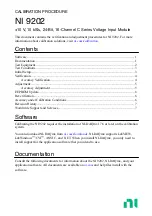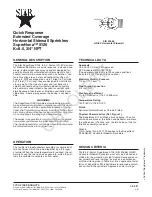
Disposal
a) General instructions
Please dispose of the device when it is no longer of use, according to the current statutory
requirements.
b) Batteries and Rechargeable Batteries
As the end user, you are required by law (Battery Ordinance) to return all used batteries/rechargeable
batteries; disposal of them in the household waste is prohibited!
Contaminated batteries/rechargeable batteries are labelled with these symbols to indicate that
disposal in the domestic waste is forbidden. The designations for the heavy metals involved are:
Cd = Cadmium, Hg = Mercury, Pb = Lead.
You can return used batteries/rechargeable batteries and button cells free of charge to any authorised
disposal station in your area, to our stores or to any other store where batteries/storage batteries/button
cells are sold.
You thereby ful
fi
l your statutory obligations and contribute to the protection of the environment.
Maintenance and Cleaning
Apart from the occasional battery change, the product is maintenance-free for you.
To clean the outside of the product, a dry, soft, clean cloth is suf
fi
cient. Do not use any aggressive detergent
as this might cause discolouration.
Declaration of Conformity (DOC)
We, Conrad Electronic, Klaus-Conrad-Straße 1, D-92240 Hirschau, hereby declare that this product
conforms to the fundamental requirements and the other relevant regulations of the directive 1999/5/EC.
☞
The Declaration of Conformity for this product can be found at www.conrad.com.
Technical Data
a) Wireless bell push
Power supply .................................... 1 Type “23A” 12 V battery
Transmission frequency.................... 433.92 MHz
Transmission range .......................... up to 80m (open space, see chapter “Range”)
LED ................................................... Lights up brie
fl
y on the use of the buttons
Protection type .................................. IP44
Dimensions (LxWxH) ........................ approx. 78 x 39 x 22 mm
Weight .............................................. approx. 27 g
b) Wireless chime
Power supply .................................... 3 batteries of type AA/Mignon (or through mains power cable 5 V/DC,
min. 1 A)
LED ................................................... Lights upon radio reception (pressing the wireless bell push)
Dimensions (H x W x D) ................... approx. 118 x 78 x 27 mm
Weight .............................................. approx. 92 g
These operating instructions are a publication by Conrad Electronic SE, Klaus-Conrad-Str. 1,
D-92240 Hirschau (www.conrad.com).
All rights including translation reserved. Reproduction by any method, e.g. photocopy, micro
fi
lming,
or the capture in electronic data processing systems require the prior written approval by the editor.
Reprinting, also in part, is prohibited.
These operating instructions represent the technical status at the time of printing. Changes in
technology and equipment reserved.
© Copyright 2013 by Conrad Electronic SE.
Inserting/replacing the batteries
a) Wireless bell push
Open the housing by levering off the housing cover from the back of the housing with a
fl
at screwdriver.
Insert a 12 V battery of type “23A” with correct polarity into the battery compartment (observe po
and negative/-).
Replace the housing cover until it snaps on.
The batteries need to be replaced if the range of the wireless bell push is signi
fi
cantly reduced or the function
LED no longer lights when the button is pushed.
b) Wireless chime
Open the battery compartment on the back of the wireless chime. Insert three type AA/Mignon batteries with
the correct polarity (o/Plus and -/Minus).
Close the battery compartment again.
The batteries need to be changed if the audio signal is barely audible or cannot be heard at all anymore.
Using a power cord for the wireless chime
The wireless chime can also be operated with an external power cord instead of batteries (not included,
available as accessory).
The power cord must be able to supply an output voltage of 5 V/DC and a current of at least 1 A. The round
plug must have an external Ø of 5.5 mm and an internal Ø of 2.1 mm; the middle contact must be po,
the outer contact negative/-.
☞
If you want to use a power cord, remove the batteries from the battery compartment.
Training the wireless bell push at the wireless chime
☞
The wireless bell push comes already trained at the wireless chime. Therefore, a new training
procedure is not normally required.
Should the wireless chime not respond to the wireless bell push (despite correctly-inserted new batteries),
proceed as follows:
• Open the small cover on the back of the wireless chime by removing the single screw from the cover.
• Press and hold the button that lies under it.
• Wait at least 5 seconds, and then brie
fl
y press the operating button on the wireless bell push.
☞
If the housing of the bell push is open, brie
fl
y press the button labelled “PLAY”.
The wireless chime should now play a doorbell tone. Release the button on the wireless chime; the training
process is complete.
• Close the small cover on the wireless chime again with the screw removed at the beginning.
Select chime tone
• Open the housing by levering off the housing cover from the back of the housing with a
fl
at screwdriver.
• You can check which chime tone is already selected by pressing the “PLAY” button.
• Change the chime tone by pressing the “SELECT” button (hold it depressed if needed). Repeat this until
the desired chime tone is played back.
• Close the casing again.
Operation
Press the button on the wireless bell push (about 1 second). In this process, the red function LED in the
button lights to indicate the correct function to you.
When the wireless signal is correctly received, the wireless chime plays the selected chime tone through its
speaker; the status LED on the wireless chime lights while the chime tone is played.
Transmission range
The transmission range for the radio signals between the components is up to 80m under optimum condi-
tions.
☞
This value, however, is the so-called “open space range” (the range when the transmitter and
receiver are visible to each other, without disturbing in
fl
uences).
In practice, however, there may be walls, room ceilings etc. between the transmitter and the
receiver which reduce the range accordingly.
Due to the different in
fl
uences on the wireless transmission, no speci
fi
c range can be guaran-
teed.
However, trouble-free operation is usually possible in a single family house.
The range can sometimes be limited considerably by:
• Walls, reinforced concrete ceilings
• Coated/metallised insulated glass
• Proximity to metal & conducting objects (e.g., radiators)
• Proximity to human bodies
• Broadband interference, e.g. in residential areas (DECT telephones, mobile phones, radio-controlled
headphones, radio-controlled speakers, radio-controlled weather stations, baby monitors etc.)
• Proximity to electric motors, transformers, power-supply units, computers
• Proximity to badly shielded or uncovered computers in use or other electrical appliances


























